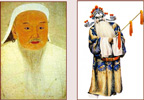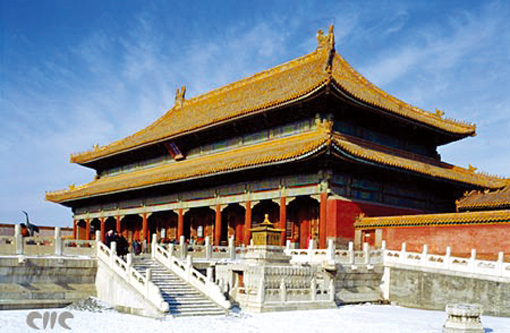| 2100-1600 |
B.C. Xia Dynasty (夏) |
| 1600-1046 |
 B.C. Shang Dynasty (商) B.C. Shang Dynasty (商)
Known for advanced
bronze-works |
| 1046-256 B.C. |
Zhou Dynasty (周)
1046-771 BC: Western Zhou (西周)
771-256 BC: Eastern Zhou (东周)
770-475 B.C: Spring and Autumn Period (春秋)
475-221 B.C.: Warring State Period (战国) |
| 221-206 B.C. |
Qin Dynasty (秦)
 Qin Shihuangdi becomes the first Emperor of China (221), begins linking defensive walls of the
various states into the Great Wall of China. Life-size terra cotta army buried with him is discovered in Xi'an in 1974 Qin Shihuangdi becomes the first Emperor of China (221), begins linking defensive walls of the
various states into the Great Wall of China. Life-size terra cotta army buried with him is discovered in Xi'an in 1974

|
| 206 B.C.-220 A.D. |
Han Dynasty (汉)
Establishes model for imperial order, and national consciousness as Han people. Paper developed, Buddhism introduced
206 B.C.-9 A.D: Western (former) Han (西汉)
25 -220 A.D.: Eastern (later) Han (东汉) |
| 220-265 A.D. |
Three Kingdoms (三国) |
| 265-316 A.D. |
Western Jin (西晋) |
| 317-420 A.D. |
Eastern Jin (东晋) |
| 420-589 A.D. |
Period of Southern and Northern Dynasties (南北朝) |
| 581-618 A.D. |
Sui Dynasty (隋) |
| 618-907 A.D. |
Tang Dynasty (唐)
 Capital established in Chang’an (now Xi’an), Empress Wu Zetian (690-705) only female ruler in China’s history.
Islam introduced. Capital established in Chang’an (now Xi’an), Empress Wu Zetian (690-705) only female ruler in China’s history.
Islam introduced.

Wu Zetian |
| 907-960 A.D. |
Five Dynasty (五代) |
| 907-979 A.D. |
Ten Kingdoms (十国) |
| 907-1125 A.D. |
Liao Dynasty (辽)
|
| 1115-1234 A.D. |
Jin Dynasty (金) |
| 960-1279 A.D. |
Song Dynasty (宋)
Earliest formula of gunpowder recorded (1044), use of compass recorded (1119), possible use back in 3rd century A.D., synagogue built in Kaifeng (1163).
960-1127 A.D.: Northern Song (北宋)
1127-1279 A.D.: Southern Song (南宋) |
| 1279-1368 A.D. |
Yuan Dynasty (元)
 Mongol ruler uses Beijing
as capital,
Beijing opera developed. Mongol ruler uses Beijing
as capital,
Beijing opera developed. |
| 1368-1644 A.D. |
Ming Dynasty (明)
 Construction of the Forbidden City started (1406), Temple of Heaven built (1420). Muslim Grand Eunuch Zheng He leads seven expeditions to India, Persia, and Africa (1405-33). Jesuit Father Matteo Ricci arrives in Macau, responsible for introducing western scientific knowledge to China (1583). Construction of the Forbidden City started (1406), Temple of Heaven built (1420). Muslim Grand Eunuch Zheng He leads seven expeditions to India, Persia, and Africa (1405-33). Jesuit Father Matteo Ricci arrives in Macau, responsible for introducing western scientific knowledge to China (1583).

|
| 1644-1911 A.D. |
Qing Dynasty (清)
The Manchus take over China and found the Qing dynasty (1644) The two Opium Wars (1839-42, 1856-60) result in ceding Hong Kong and Kowloon to Britain. Taiping Rebellion (1851-66), French and British troops burn Yuanming Yuan (1860). China is defeated in First Sino-Japanese War (1894-95), Taiwan becomes a Japanese colony. Eight-Nation Alliance invade Beijing to suppress Boxer Rebellion (1900) |
| 1784 |
Trader ship “Empress of China”arrives at Canton, a southern port in China
|
| 1830s |
Chinese working in Hawaii, and appearing in New York |
| 1844 |
U.S. and China sign “Treaty of Wangxia” |
| 1865 |
Central Pacific Railroad Co. recruits Chinese workers for the transcontinental railroad |
| 1869 |
The Library of Congress receives first exchange of annotated books from Emperor T’ung- Chih |
| 1872-75 |
One hundred twenty “Boy students” age 12-15, from China come to the U.S. to study. Upon return to China, they become leaders in government, military, technology, education and science. |
| 1882 |
U.S. Congress passes the Chinese Exclusion Act |
| 1894 |
 Sun Yat-sen founds the Xingzhonghui in Honolulu which eventually leads to the toppling of Qing Dynasty and the founding of Republic of China. Sun Yat-sen founds the Xingzhonghui in Honolulu which eventually leads to the toppling of Qing Dynasty and the founding of Republic of China. |
| 1900 |
U.S. and seven other nations send troops to Beijing suppressing “Boxer Rebellion” |
| 1911-1949 |
A.D. Republic of China (中华民国)
Dr. Sun Yat-sen topples Qing Dynasty, ending 5000 years of imperial rule and establishes Republic of China (1911), China declares war on Germany and enters WWI (1917), "May Fourth Movement" students denounce Japan and foreign imperialisms (1919), Japan invades China (1937-45), Taiwan is
returned to China after Japan surrenders in 1945. |
| 1911 |
U.S. Congress approves using settlement funds to set up Tsinghua Preparatory School, predecessor of present-day Tsinghua University
|
| 1913 |
U.S. recognizes Republic of China
|
| 1940s |
General Chenault leads Flying Tigers to help China fight Japanese
|
| 1942 |
General Stilwill appointed as the U.S. Army representative in China |
| 1943 |
“Cairo Declaration” signed by Roosevelt (U.S.), Churchill(UK) and Jiang Kai-shek (China), addresses the Allied position against Japan and makes decisions about postwar Asia U.S. Congress repeals all Chinese exclusion laws, grants right of naturalization |
| 1949-Present |
People's Republic of China (PRC)
(中华人民共和国)
Founded under Communist party. The Great Leap Forward movement (1958-60), Cultural Revolution (1966-76), Suppression of student protest in Tiananmen Square (1989), Britain retrocedes Hong Kong to mainland China (1997). In 2001, China joins World Trade Organization (WTO), Beijing is selected to host the Olympic Games in 2008. |
| 1950 |
Korean War breaks out |
| 1954 |
The Sino-American Mutual Defense Treaty is signed between Taiwan and the U.S. |
| 1971 |
UN admits communist Chinese PRC, “Ping Pong Diplomacy” American athletes become the first to officially visit China since 1949 |
| 1972 |
 President Nixon visits China, signs “Shanghai Communique” President Nixon visits China, signs “Shanghai Communique” |
| 1979 |
Resumption of diplomatic relations between the PRC and the U.S., U.S. Congress implements Taiwan Relations Act. |



